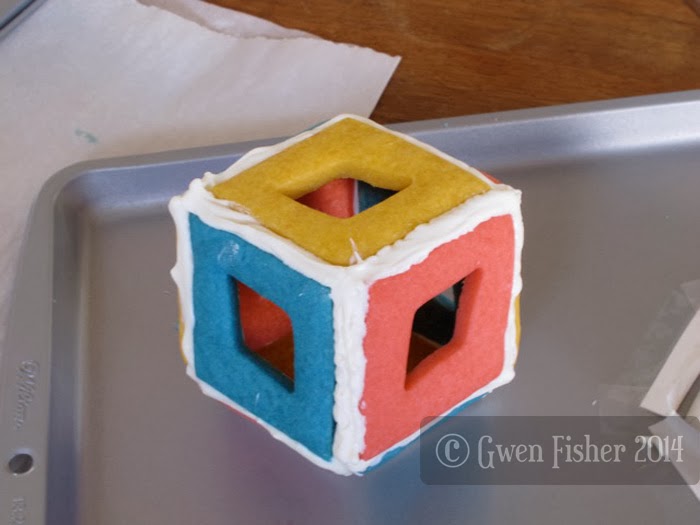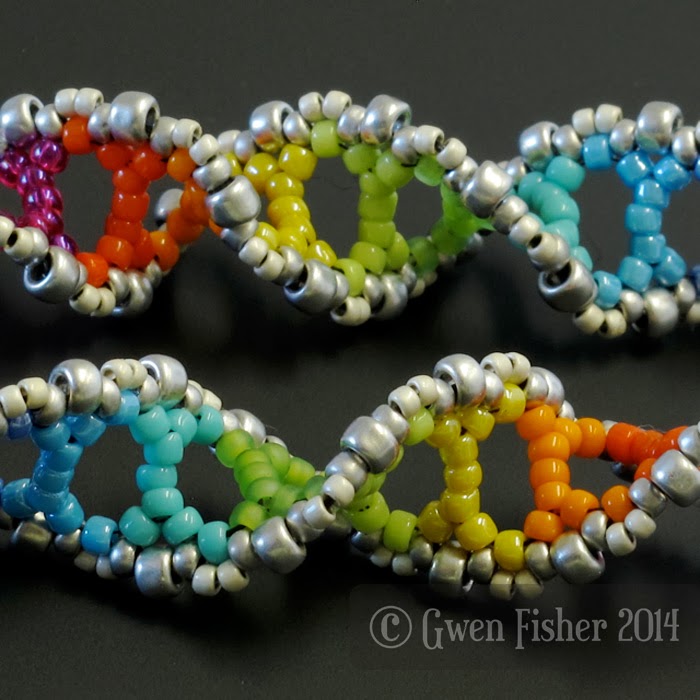We made math cookies! More specifically, we formed mathematical objects out of shortbread and white chocolate. These photos show the combined confectionery efforts of Ruth Fisher, Andrea Hawksley, Vi Hart, and myself.
Here you can see our set up. We rolled out the colored shortbread dough using some plastic strips so that we would get a nice, evenly thick sheet of dough. Here we are cutting (1 : root2) rhombuses with 60° rhombus holes. We were able to cut the holes with that little metal cookie cutter, but we had to use a knife and straightedge to cut the larger rhombi.
With the little 60° rhombuses that were in the holes, we made a tiling.
Here's the shortbread tiling, before baking.
Shortbread tiling, after baking.
Can you guess what we made with the bigger rhombuses?
Here you can see them being assembled on jig made from paper and tape.
We made a rhombic dodecahedron, called that because it has 12 faces, each of which is a rhombus.
Here's the complete rhombic dodecahedron assembled with white chocolate.
Here we are assembling the truncated icosahedron with melted white chocolate.
Here you can see all three of the truncated regular polyehedra we made. Notice we just used one cookie cutter for all of these cookies, a hexagon. In fact, it was BECAUSE we had a hexagonal cookie cutter that we decided to make these particular shapes.
Quasiperiodic cookies taste better than nonperiodic ones. We had to make our own cookie cutters for this piece. We made them out of paper and tape. This is called a Penrose tiling. We wanted to decorate it with white chocolate to show an isomorphic tiling on top, but we found an error. To anybody else who can find the error, you will receive two points and a gold star.
This is a short braid made out of shortbread.
With the last bits of dough, we made lots of little tetrahedral cookies.
We assembled these tetrahedrons into second generation Sierpinski tetrahedral cookies with white chocolate. This actually worked better than I thought it would. Unfortunately, we ran out of dough before we could make the third generation.
They were delicious. Thanks for looking.
Updates: Vi Hart also created a video of our cookies making adventure. She's a wonderful story teller, and among other things, she included my dog Walter's involvement in our day of making cookies. Check it out. http://www.youtube.com/watch?v=_n1126GoxbU
We even made it on BoingBoing! http://boingboing.net/2014/03/04/cookie-geometry-with-vi-hart.html
Here you can see our set up. We rolled out the colored shortbread dough using some plastic strips so that we would get a nice, evenly thick sheet of dough. Here we are cutting (1 : root2) rhombuses with 60° rhombus holes. We were able to cut the holes with that little metal cookie cutter, but we had to use a knife and straightedge to cut the larger rhombi.
With the little 60° rhombuses that were in the holes, we made a tiling.
Here's the shortbread tiling, before baking.
Shortbread tiling, after baking.
Can you guess what we made with the bigger rhombuses?
Here you can see them being assembled on jig made from paper and tape.
We made a rhombic dodecahedron, called that because it has 12 faces, each of which is a rhombus.
Here's the complete rhombic dodecahedron assembled with white chocolate.
Then we started assembling our blue hexagons. Here's the jig for a truncated octahedron.
Here's the jig for a truncated icosahedron.Here we are assembling the truncated icosahedron with melted white chocolate.
Here you can see all three of the truncated regular polyehedra we made. Notice we just used one cookie cutter for all of these cookies, a hexagon. In fact, it was BECAUSE we had a hexagonal cookie cutter that we decided to make these particular shapes.
Quasiperiodic cookies taste better than nonperiodic ones. We had to make our own cookie cutters for this piece. We made them out of paper and tape. This is called a Penrose tiling. We wanted to decorate it with white chocolate to show an isomorphic tiling on top, but we found an error. To anybody else who can find the error, you will receive two points and a gold star.
This is a short braid made out of shortbread.
With the last bits of dough, we made lots of little tetrahedral cookies.
We assembled these tetrahedrons into second generation Sierpinski tetrahedral cookies with white chocolate. This actually worked better than I thought it would. Unfortunately, we ran out of dough before we could make the third generation.
They were delicious. Thanks for looking.
Updates: Vi Hart also created a video of our cookies making adventure. She's a wonderful story teller, and among other things, she included my dog Walter's involvement in our day of making cookies. Check it out. http://www.youtube.com/watch?v=_n1126GoxbU
We even made it on BoingBoing! http://boingboing.net/2014/03/04/cookie-geometry-with-vi-hart.html







































